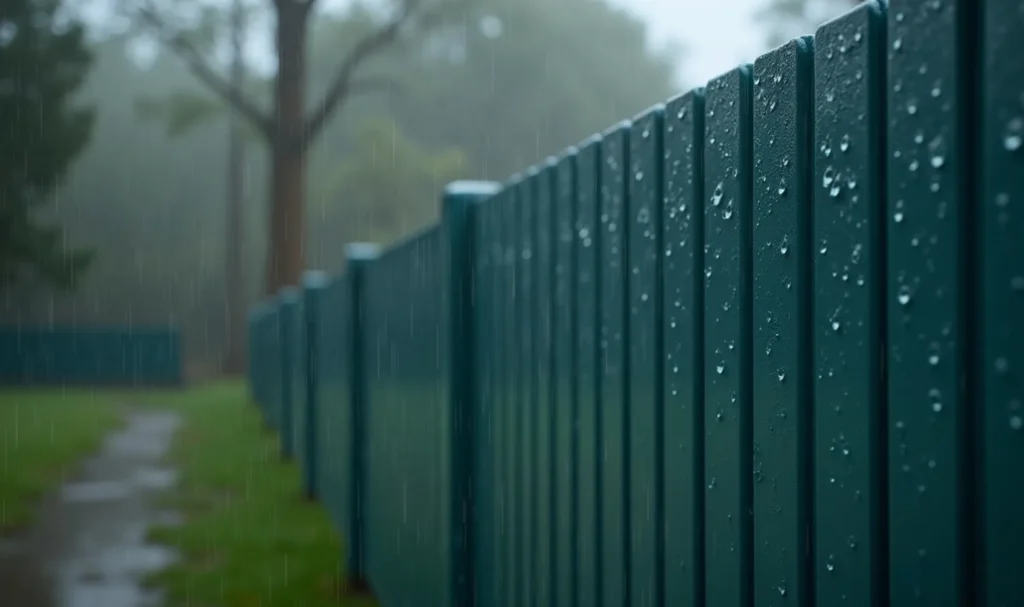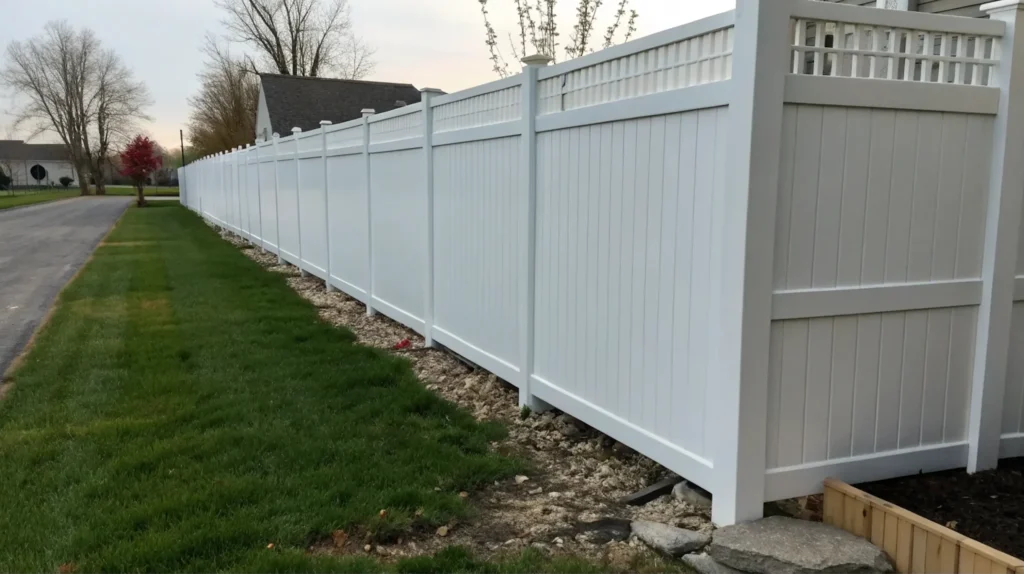When thinking about adding a new fence around your property, vinyl fencing is an option that has been gaining popularity. It combines aesthetics, durability, and low maintenance, making it an attractive choice for homeowners. Whether you're looking to enhance your property’s appearance, secure your yard, or increase privacy, this guide will walk you through everything you need to know about vinyl fencing, ensuring you make the right decisions for your home.
Vinyl Fencing
Vinyl fencing has transitioned from a niche product to a household staple in many areas across the U.S. Its rise in popularity can be attributed to its mix of durability, aesthetic appeal, and maintenance-free advantages. Unlike traditional fencing materials such as wood or iron, vinyl does not rot, rust, or need frequent painting. This makes it an appealing choice for individuals looking for a long-term investment in their property.
In recent years, innovations in manufacturing have allowed vinyl fences to mimic the appearance of wood and other materials, offering a variety of styles perfect for any home. Be it classic white picket or contemporary vertical panels, vinyl provides a versatile look while still ensuring security and privacy.
Understanding Vinyl Fencing
Before diving into the numerous options available for vinyl fencing, it’s essential to gain a deeper understanding of what vinyl fencing is composed of. Made primarily from polyvinyl chloride (PVC), vinyl fences are robust, UV-resistant, and designed to withstand harsh weather conditions. PVC fencing has been utilized since the 1980s, but advancements in technology have significantly improved its structural integrity and design options over the years.
Vinyl fencing is available in a variety of textures, colors, and styles, allowing homeowners to select a look that complements their property’s unique charm. Additionally, various manufacturers offer different warranties that assure buyers of product excellence and longevity.
Benefits of Vinyl Fencing
One of the first considerations for homeowners is the potential advantages a vinyl fence can provide. Here are several benefits that make vinyl fencing an attractive option:
- Low Maintenance: Classic wooden fences often require staining, painting, or sealing. Vinyl fencing, on the other hand, usually requires minimal care; a quick wash with soap and water will do the trick.
- Durability: Vinyl can resist adverse weather conditions, making it an excellent choice for areas prone to extreme weather. The material is resistant to pests and won't splinter or warp over time.
- Aesthetic Flexibility: As mentioned earlier, vinyl can replicate looks of other materials without sacrificing quality. This allows homeowners numerous design options to fit their landscaping and home architecture seamlessly.
Durability of Vinyl Fencing
When investing in any exterior element of your home, durability is a significant factor to consider. Vinyl fencing is engineered to last for decades, ensuring less hassle and expense in the long run. The UV inhibitors present in vinyl fencing help prevent fading in sunlight, while its resilience protects against cracking and breaking during severe weather events.
Furthermore, vinyl fences do not suffer from common issues associated with wood, such as decay and insect infestation. Many vinyl fences on the market come with lifetime warranties that reaffirm their durability claims, ensuring peace of mind for homeowners.
Cost-Effectiveness of Vinyl Fencing
Cost is often a significant part of the conversation when deciding on a new fence. While vinyl fencing has a higher upfront cost than wood, it quickly makes up for it in lifespan and low maintenance requirements. Homeowners need to consider the total cost of ownership over time, including projected repairs and maintenance of other types of fencing.
In addition to the durability aspect, vinyl can also increase property value, especially when installed properly and well-maintained. A beautifully designed fence can enhance the curb appeal of a home, making it more attractive to prospective buyers. The long-term investment of a vinyl fence results in both savings and potential appreciation in your home’s value.
Styles of Vinyl Fencing
Choosing the right style of vinyl fence is crucial in achieving the desired look and function for your home. Let’s take a look at some of the popular styles available:
- Privacy Fencing: Tall and solid panels provide maximum privacy and security. Ideal for urban areas where homes are close together.
- Picket Fencing: Classic and charming, picket fences are low and welcoming. Great for front yards and decorative boundaries.
- Semi-Privacy Fencing: A balance between privacy and openness, these fences feature boards with small gaps, allowing visibility while still providing some privacy.
- Ranch Rail Fencing: Usually found in rural settings, ranch rail fences feature horizontal rails and are perfect for delineating property boundaries without blocking views.
Choosing the Right Style for Your Property
While the various styles of vinyl fences are certainly appealing, choosing the right one for your situation can be daunting. When assessing which style fits your property best, consider factors such as your home’s existing design, your primary purpose for the fence (privacy, security, aesthetic), and any relevant neighborhood guidelines or homeowner association (HOA) rules.
It's also essential to take into account the climate in your region. If you live in a particularly windy area, opting for a solid privacy fence can help reduce wind resistance. On the other hand, if you want to create an inviting entrance, a charming picket fence may be the way to go.
Vinyl Fencing vs. Other Materials
Comparing vinyl fencing to traditional materials such as wood, metal, and chain link can shed light on its unique advantages.
- Wood: Although wooden fences are aesthetically pleasing, they require more upkeep and can be affected by rot and termites. Vinyl fencing allows homeowners to enjoy a more sustainable choice without the constant maintenance.
- Metal: While metal fences offer durability, they can be prone to rust and corrosion. Vinyl, however, retains its appearance and integrity through various weather conditions.
- Chain Link: While chain link fences are affordable, they lack privacy and aesthetic appeal. Vinyl provides a more attractive appearance while maintaining security.
In weighing these choices, vinyl fencing emerges as a valuable competitor in both performance and aesthetics.
Installation of Vinyl Fencing
When it comes to the installation of vinyl fencing, there are two primary avenues: DIY installation and hiring professionals. DIY can be a fulfilling and cost-effective option, but it requires certain skills and tools.
DIY vs. Professional Installation
Opting for a DIY installation can save money, but it’s essential to be realistic about your skills. Measurement and leveling can be challenging, and mistakes may lead to extra time and expense.
Conversely, hiring professionals ensures that the installation process is handled correctly. Experienced installers will have the tools and expertise needed to complete the fence efficiently no matter the style or terrain. In the long run, their work can end up saving you both time and money.
Essential Tools for Installing Vinyl Fencing
If you decide to embark on a DIY project, it's imperative to have the right tools at your disposal. Some of the essential tools for installing vinyl fencing include:
- Post Hole Digger: To create holes for the fence posts.
- Level: To ensure your fence is straight and properly aligned.
- Tape Measure: For accurate measurements to guarantee proper fitting.
- Power Drill: For securing fasteners into the vinyl.
- Saw: If adjustments are necessary for a perfect fit.
Maintenance of Vinyl Fencing
One of the standout benefits of vinyl fencing is its low maintenance requirements. Fencing made from vinyl is resistant to elements that typically damage wood, making care easier for homeowners.
Cleaning Your Vinyl Fence
Periodically washing your vinyl fence helps keep it looking its best. A mixture of warm water and mild soap is often effective. You can use a soft brush or sponge to scrub away any dirt or stains, while a hose is ideal for rinsing away any soap residue.
How to Repair Vinyl Fencing
While vinyl is durable, it’s not indestructible. In the unlikely event your vinyl fence sustains damage – such as a crack or a broken panel – repairs can often be handled easily. Many companies sell replacement parts, allowing you to restore your fence without needing a complete replacement.
Vinyl Fencing and Property Value
Investing in a vinyl fence is not only beneficial to your property at present, but it can also enhance property value in the future. The visual appeal and security provided by a high-quality vinyl fence can lead to increased demand among potential buyers. Well-constructed homes with attractive upgrades tend to stand out in the real estate market.
Environmental Impact of Vinyl Fencing
For those concerned about the environment, it’s worth noting that vinyl fencing is recyclable, providing an eco-friendlier option compared to materials like pressure-treated wood. Additionally, during its manufacturing, there are more sustainable choices available that minimize the overall environmental impact. This circular nature of vinyl fencing offers homeowners a path to reduce their ecological footprint.
Frequently Asked Questions
Is vinyl fencing easy to install?
Vinyl fencing can be straightforward to install, especially with the right tools. However, hiring professionals ensures optimal results and saves you time.
What is the average cost of vinyl fencing?
The cost of vinyl fencing can vary based on design, height, and local prices, ranging anywhere from $20 to $40 per linear foot, including installation.
Does vinyl fencing fade over time?
While high-quality vinyl fencing contains UV inhibitors to mitigate fading, it can still occur over many years. Regular cleaning can help maintain its vibrant appearance.
Can I customize my vinyl fence?
Absolutely! Vinyl fencing comes in various styles and colors, and many manufacturers offer customization options to fit your design preferences.
How long does vinyl fencing last?
On average, vinyl fencing can last anywhere from 20 to 30 years with proper care and maintenance, making it a long-lasting investment.
Is vinyl fencing safe for pets?
Vinyl fencing provides a secure environment for pets, as it cannot splinter or break easily. It’s great for keeping your furry friends contained.
Customer Testimonials and Experiences
Many homeowners who have opted for vinyl fencing share their positive experiences. They appreciate how it transforms their yards, enhancing appearance while providing safety and security. The meld of durability and design has turned vinyl fencing into a highly recommended choice.
Conclusion
Choosing vinyl fencing for your home is a decision that can offer long-term benefits, visually and in terms of maintenance. With its variety of styles, low upkeep, and durability, vinyl fencing meets the diverse needs of homeowners today. By thoroughly understanding the ins and outs of vinyl fencing, you can confidently select the right options for your property. Happy fencing!



